Stepping out and creating overloads in a 3-5-2
The 3-5-2 formation remains hugely popular in modern football, though with so many teams becoming smart to its threat, we need players to be adept and precise in their execution of the set-up if it is to continue to reap rewards.

| Area | Up to a half-pitch |
| Equipment | Balls, cones, discs, goals, mannequins |
| No. of Players | 11v11 |
| Session Time | Warm-up and progression 20mins, Boxes set-up and progression 40mins |
The 3-5-2 formation remains hugely popular in modern football, though with so many teams becoming smart to its threat, we need players to be adept and precise in their execution of the set-up if it is to continue to reap rewards.
For me, it’s always been a formation that offers strength across the middle of the park, yet this practice emphasises how the real impact of the set-up isn’t in fact created by five across the middle, but the flexibility and versatility of the attacking and defending areas in front of and behind.
And not only will mastering the mechanics of this session help players become proficient in the elements of 3-5-2, they will notice increased technical ability and smarter movement as well, both in their own game and that of their team mates.
What do I get the players to do?
Passing warm-up
The warm-up is played in a relatively small area – perhaps 40x40 yards – to enable lots of repetition and full involvement by all.
Reds start in possession of the ball (1) – when every player has had a touch it’s switched to the whites who must do the same. Teams must avoid tackles or interceptions through communication, organisation and good technical skills.
1
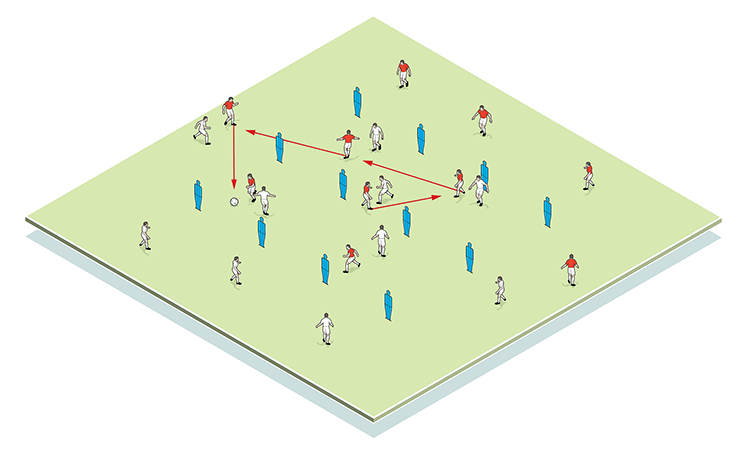
Once mastered, we progress the session by introducing picture cards to the team in possession. The card will depict a ‘picture’ of play that has to be followed – this, for instance, could be the ball being passed only clockwise (2), or just on one side of the playing area, or each player receiving the ball and dribbling forward a yard before passing. Whatever the instruction, the card must only be visible to the team in possession so that pressing opponents do not know the game plan.
2
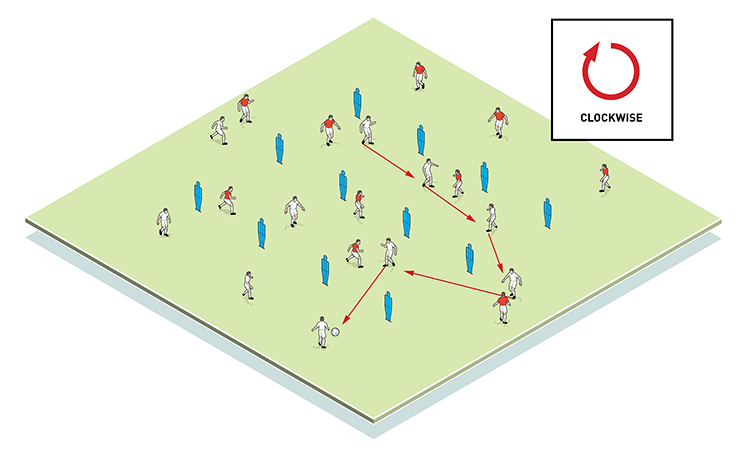
We can then move the session on again by adding a goal at each end (3). Now teams play to a finish once every player has had a touch of the ball, breaking towards goal against three defenders and shooting.
3
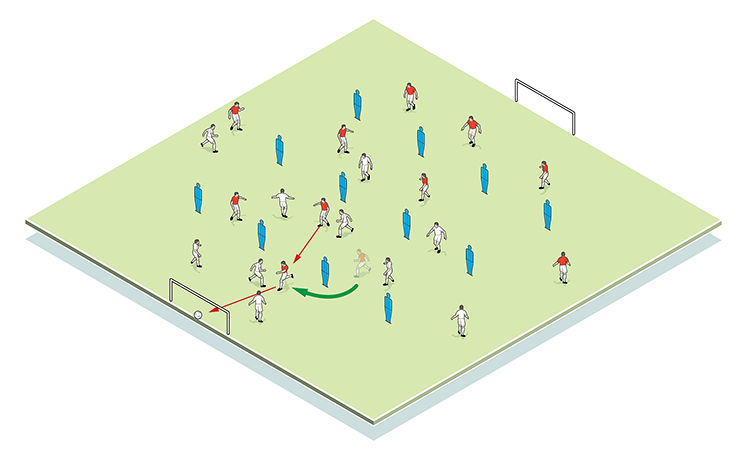
What are the key things to look out for?
We’re looking for good awareness, movement, excellent technical skills and positive passing moves . In the case of the defending team, we want excellent pressing ability and, if possible, the psychological wherewithal to work out their opponents’ game plan.
Boxes set-up
Now, setting up as shown (4), red defenders can only have one of three midfielders in a box at any one time. Whites, meanwhile, must make sure they occupy each of the four boxes by using wide players, strikers or even centre-halves stepping into the free box. The objective for whites is simply to find the spare man in a box, then attack from this trigger.
4
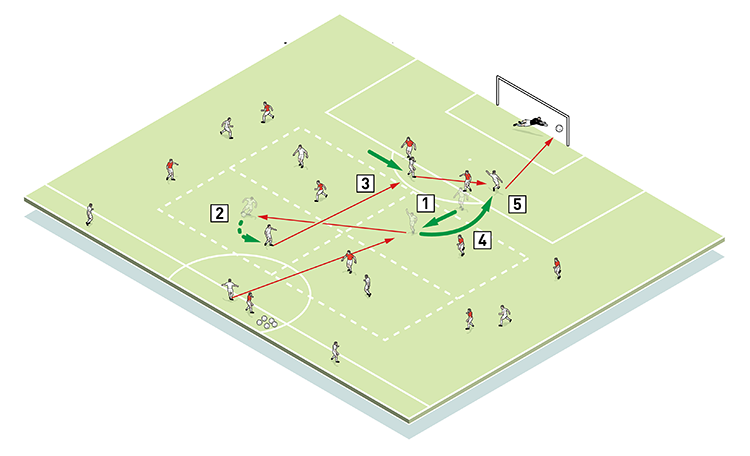
2. He receives the pass and moves it to the team mate who isn’t being marked in his box
3. A direct pass through the middle finds the attacker
4. His fellow frontman now breaks for the box
5. He receives the pass and a goal is scored
In the event of a turnover, players must reorganise quickly.
What are the key things to look out for?
Awareness of team mates is key, finding the spare man with clever passing. Speed of play is also vital, particularly when the ball is switched into the final third, while players supporting others in their movement (for instance, the opposite wing-back getting into the box from crosses) is essential.
In the progression, we set up a scenario that mimics opponents defending narrow (5) by dropping two more red players into the central boxes. The emphasis is now on whites to circumnavigate the narrow block by switching play and moving the ball outside the boxes.
5
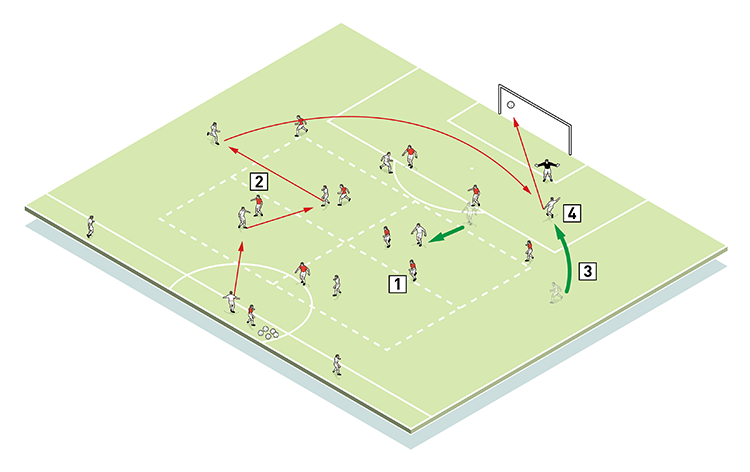
2. Whites move the ball smartly and a pass is fed to the wing
3. The opposite winger makes a run into the penalty area
4. The cross is attacked and a goal scored
Editor's Picks
Attacking transitions
Deep runs in the final third
Using the goalkeeper in build-up play
Intensive boxes drill with goals
Penetrating the final third
Creating and finishing
My philosophy
Pressing initiation
Compact team movement
Coaches' Testimonials

Alan Pardew

Arsène Wenger

Brendan Rodgers

Carlos Carvalhal

José Mourinho

Jürgen Klopp

Pep Guardiola

Roy Hodgson

Sir Alex Ferguson

Steven Gerrard
Coaches' Testimonials

Gerald Kearney, Downtown Las Vegas Soccer Club

Paul Butler, Florida, USA

Rick Shields, Springboro, USA

Tony Green, Pierrefonds Titans, Quebec, Canada
Join the world's leading coaches and managers and discover for yourself one of the best kept secrets in coaching. No other training tool on the planet is written or read by the calibre of names you’ll find in Elite Soccer.
In a recent survey 92% of subscribers said Elite Soccer makes them more confident, 89% said it makes them a more effective coach and 91% said it makes them more inspired.
Get Monthly Inspiration
All the latest techniques and approaches
Since 2010 Elite Soccer has given subscribers exclusive insight into the training ground practices of the world’s best coaches. Published in partnership with the League Managers Association we have unparalleled access to the leading lights in the English leagues, as well as a host of international managers.
Elite Soccer exclusively features sessions written by the coaches themselves. There are no observed sessions and no sessions “in the style of”, just first-hand advice delivered direct to you from the coach.









